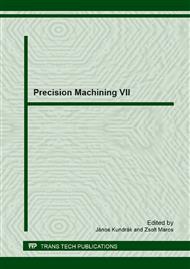p.131
p.137
p.143
p.148
p.157
p.163
p.169
p.176
p.182
Study of the Effect of the Cutting Force Decomposition on Machined Surface when Hard Turning
Abstract:
Hard turning is well known as removal process making the most of very small chip cross sections. Because of the tool nose radiustodepth of cut ratio, forces in hard machining gather their effects at tool nose radius to produce parasitic portions in all components of resultant cutting force. In order to identify parasitic forces, chip cross sections have been modeled as projections of the shear planes. Based on measured forces data and roughness' in hard turning with cubic boron nitride inserts , the ratios of parasitic effects on resultant surface roughness have been determined. Specific forces per chip cross section/tool edge result from decomposition of measured data in hard turning. Results showed that there is considerable relationship between parasitic portions in passive forces and resultant surface roughness.
Info:
Periodical:
Pages:
157-162
Citation:
Online since:
October 2013
Authors:
Price:
Сopyright:
© 2014 Trans Tech Publications Ltd. All Rights Reserved
Share:
Citation:


